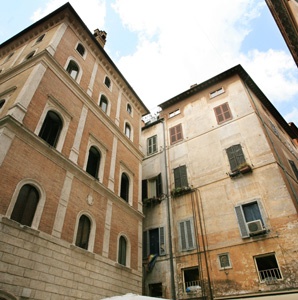
Meander the hidden backstreets of these Rome enclaves—and prepare to be delighted.
See the Globetrotter’s Guide to World Hot Spots.
Descriptions of Rome tend toward hyperbole (see Byron, Henry James, Stendhal). It’s splendid; majestic; swoon-inducing. But what about the areas where the city’s majesty defers to the more prosaic dimensions of everyday life, without diminishing any of Rome’s special allure? Such a balance is struck in the historic rioni (districts) of Ponte, Parione, and Regola, which together run west from the Piazza Navona to the curve of the Tiber, and south to the Piazza Farnese. They boast no Pantheon, no St. Peter’s, but thanks to several centuries’ accretion of buildings both noble and humble, their mazelike streets are rife with happy accidents of space and beauty: All you have to do is turn a corner, and a crooked, eight-foot-wide lane suddenly gives onto a sun-washed piazza; or a cacophony of revving Vespas fades into a silence broken only by the trickling of a wall fountain. Lately these rioni have attractions of a wholly contemporary sort. Urbane, one-off boutiques line Parione’s Via del Governo Vecchio, and the surrounding streets hold restaurants and bars where stylists and students, actors and titled dilettantes all gather to fare la bella figura. This is, after all, an area that Romans very much still claim for themselves. That’s not to say you’re not welcome here. Just keep the superlatives to a minimum. —Maria Shollenbarger
Arsenale: Arsenale caters to those seeking something different in fashion. Here, designer and owner Patrizia Pieroni showcases her creations, from pink, pale gray, and lilac shantung dresses to bulky knit jackets that have won her attention in Vogue magazine. Customers also come to ultra-white Arsenale in central Rome for the seductive bustiers, shoes, and accessories. As Pieroni reminds, with “an accessory you change the dress.” Considering art just another face of visual communication, the second floor of her Via del Pellegrino address is now a dedicated art gallery.
Bolero: Gabriella Bolero’s flagship opened in November selling the designer’s signature women’s clothes.
Chiostro del Bramante: Built in 1504 and attached to the church of Santa Maria della Pace in Rome’s Centro Storico, Chiostro del Bramante was one of architect Donato Bramante’s first projects in the Eternal City. This former 16th-century cloister is now an art venue and cultural center featuring an array of modern and ancient pieces ranging from iconic works by Andy Warhol and Jean-Michel Basquiat to Julius Caesar artifacts. Under the second-floor porticos, there’s a café that provides espresso, free Wi-Fi, and American-style bacon and eggs. The gallery is closed on Mondays.
Cul de Sac: Located near Piazza Navona and the historic statue of Pasquino Viviana, Cul de Sac serves both traditional Roman favorites and Greek and Arabic fare. Inside, stacks of wine bottles hide the restaurant's walls, and outdoor seating provides a view of the piazza. Enjoy Cul de Sac’s famous sundried tomatoes in Calabrian olive oil or sample the more unique entrees, such as wild boar pâté and baba ghanoush (mashed eggplant). One of Rome’s oldest enoteche (wine repositories), Cul de Sac also offers the wine lover 1,500 wine labels of many varieties.
Gonfalone: Located at 7 Via Gonfalone and housed in a 16th-century building, Gonfalone restaurant offers guests the chance to relax and dine inside before a tall, copper-hooded fireplace or beneath lanterns filled with flickering candles. The scialatielli (fat Neapolitan spaghetti) with clams, fresh zucchini and tomato is a standout, but more familiar combinations such as meatballs and spaghetti with porcini mushrooms are available. Outdoor dining is available.
Hotel Raphael: A favorite of Italian politicians, the ivy-covered Hotel Raphael is located just outside the Piazza Navona, within walking distance of the Pantheon and Spanish Steps. Inside, the lobby is decorated with a museum-quality art collection that includes Picasso ceramics and paintings by Miró and de Chirico. Most of the 50 guestrooms have hardwood floors and antique furnishings, while the two executive floors—designed by renowned architect Richard Meier—are more modern, with oak, leather, and Carrera marble accents. The rooftop restaurant serves Mediterranean cuisine amid panoramic views of the city, including the Pantheon, Piazza di Spagna, and St. Peter’s Basilica.
Ilaria Miani: Started in 1982, this interior design shop takes its namesake from owner Ilaria Miani, an Italian interior designer who is known for her proficiency in Italian rustic architecture and blending ancient and modern designs. Her shop is filled with one-of-a-kind pieces of furniture that range from customizeable sofas to iron tables to wooden desks. There's even a selection of accessories, including lamps, mirrors, and handmade ceramic dinnerware. The more than 200 products are designed to be used both inside and outside and come in assorted finishes, including mahogany, cherrywood, black ebony, silver and gold leaf wood, and iron and laque.
Josephine de Huertas & Co: A peek in the window reveals light pink walls, soft lighting, and minimal decor because at Josephine de Huertas & Co., it’s all about the clothes, accessories, and shoes, of course. This is where Romans get their fix of designers like Chloé, Missoni, Alberta Ferretti, and Anya Hindmarch. The shop is owned by fashion designers Josephine de Huertas and Mauro Crachi, who hand-pick quality collections for the shop, and around the corner is Josephine de Huertas Enfant, a children’s clothing boutique with furnishings, toys, games, and French collections like Paradis Blanc.
Pierluigi: Established in 1938, Pierluigi continues to serve authentic Italian food Campo dei Fiori neighborhood of Rome with a commitment to seasonality, tradition and creativity. Enjoy handmade gelato on the sun-drenched, cobblestoned piazza, or entrées like tenderized cutlets with cream, cognac, and red peppers and sardine spaghetti with pine nuts, fennel, and raisins inside the amber-accented dining room. Dinner can be paired with a selection from the restaurant wine list of 450 labels—everything from Pinot Noir to Tignanello. Accustomed to guests from all over the world, Pierluigi servers speak several languages.